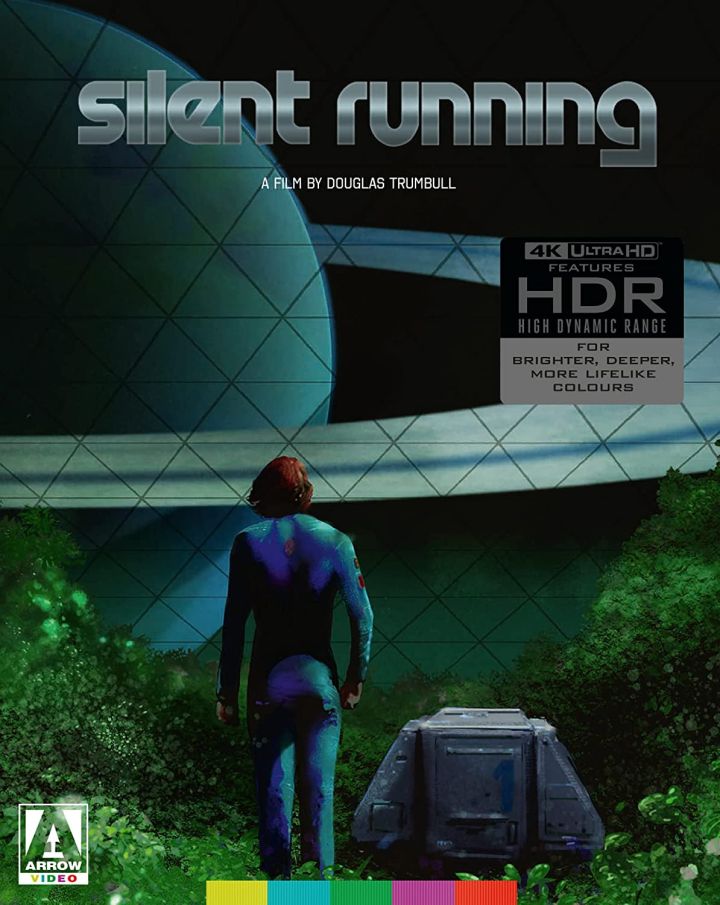
One of the things that made Star Wars such a huge hit was the state of ’70s cinematic sci-fi. Because sci-fi in the ’70s was a downer. Everything was a downer – the state of the world was not wonderful, and art will reflect, and indeed amplify that. So, a lot of the critically acclaimed movies, or those that aimed for critical acclaim were dark and negative. Dystopic sci-fi was the norm. When Star Wars came out and the good guys won in a fun adventure, it was practically a revelation.
Silent Running inspired some aspects of Star Wars, but not tone. Silent Running, directed by 2001: A Space Odyssey special effects supervisor Douglas Trumbull, was no escapist fantasy. It was deeply rooted in the concerns of the ’70s ecological movement.
Earth doesn’t grow anything anymore. Space freighters, millions of miles from Earth, harbor eco systems. These eco systems, onboard glass-domes pods, are the last remnants of natural growing things from Earth. They’re arks, essentially, with plant life that Earth can no longer sustain.
Bruce Dern is Lowell, the ecologist in charge of the eco-system on his ship, the Valley Forge. And he’s the only one of the skeleton crew of four men that seems to have any sense of mission. He maintains and cultivates the forests and gardens. The other three are just marking time until someone tells them different. They’ve been on ship for years. They don’t like the rather sanctimonious Lowell, and he doesn’t much like them.
So, when the call comes from command to scrap the mission, jettison and destroy the ecological pods and come home, the other three are just fine with it. Lowell is furious, despondent… and ultimately, mutinous. He rescues the final pod, gets rid (in various ways) of the other crew, and sends the Valley Forge off course in the hope that this last vestige of natural earth can be preserved.
Silent Running has an interesting premise, though with an unfocused attention on world building. Just how terrible life on Earth is is left a little unclear. Lowell paints it as a synthetic hellscape, but the rest of the crew is perfectly happy to throw away the trees to get home. And once Lowell enacts his haphazard mutiny, the movie kinds of runs out of story. He’s left alone on his ship and doesn’t have a lot to do.
Most of the action from there on out involves the three robot drones that do most of the maintenance on the ship. Lowell reprograms them and turns them into an ersatz crew. These awkward little robots (which move about in a charming fashion) were an inspiration for R2-D2. They’re the most likable characters in the film, but they still don’t do much.
Silent Running runs about 90 minutes but feels almost as long as 2001. It has some of the rudiments of Kubrick’s film with its long passages without dialogue and stark environments. But everything Stanley Kubrick did was with a cool intelligence. Thoughts, if not a direct message. Silent Running has a billboard in neon: nature good, man bad. And even if I was receptive to the message, I’d like it delivered with more subtlety than the garden idylls of the Valley Forge forest pod, where the raptors wouldn’t seem to think of hunting and tearing apart the copious cute bunnies that run around in plain view.
Silent Running was made with a low budget, which director Douglas Trumbull made the absolute most of. The extravagant model work still looks fantastic, and several of the shots of spaceships moving through the void. Some scenes have the secrets of the special effects laid bare by the 4K transfer, where the separate glass plates of the elements are completely visible. To me, this just makes the visual achievement of the film more apparent. A lot of work went into creating the impressive ship. In particularly the sequence where it skirts the rings of Saturn is beautiful.
Where Silent Running lets me down is in the story department. There’s a particular subgenre of movies about men left alone in space with nothing to do. This creates a story challenge, and I don’t think Silent Running meets it too well. There are individual clever moments, where Lowell and his newly reprogrammed drones seem to come to understandings of each other, but it feels a lot like marking time. Silent Running looks good, and though its story is very much rooted in its era, it is clearly heartfelt. But that doesn’t keep it from being a slow, slow film that doesn’t have enough happening, even if it looks good while not doing anything.
Silent Running has been released by Arrow Video. This 4K UHD release does not include a Blu-ray on the film. Extras on disc include a pair of commentaries: one by critics Kim Newman and Barry Forshaw, and another by director Douglas Trumbull and star Bruce Dern. Video extras include “No Turning Back” (14 min), a new interview with film music historian Jeff Bond; “First Run” (4 min), a new visual essay by writer and filmmaker Jon Spira; and several archival special features: “The Making of Silent Running” (50 min); “Silent Running by Douglas Trumbull” (30 min); “Douglas Trumbull: Then and Now” (5 min); “A Conversation with Bruce Dern” (11 min); Theatrical Trailer (3 min); Behind the Scenes Gallery (115 min).